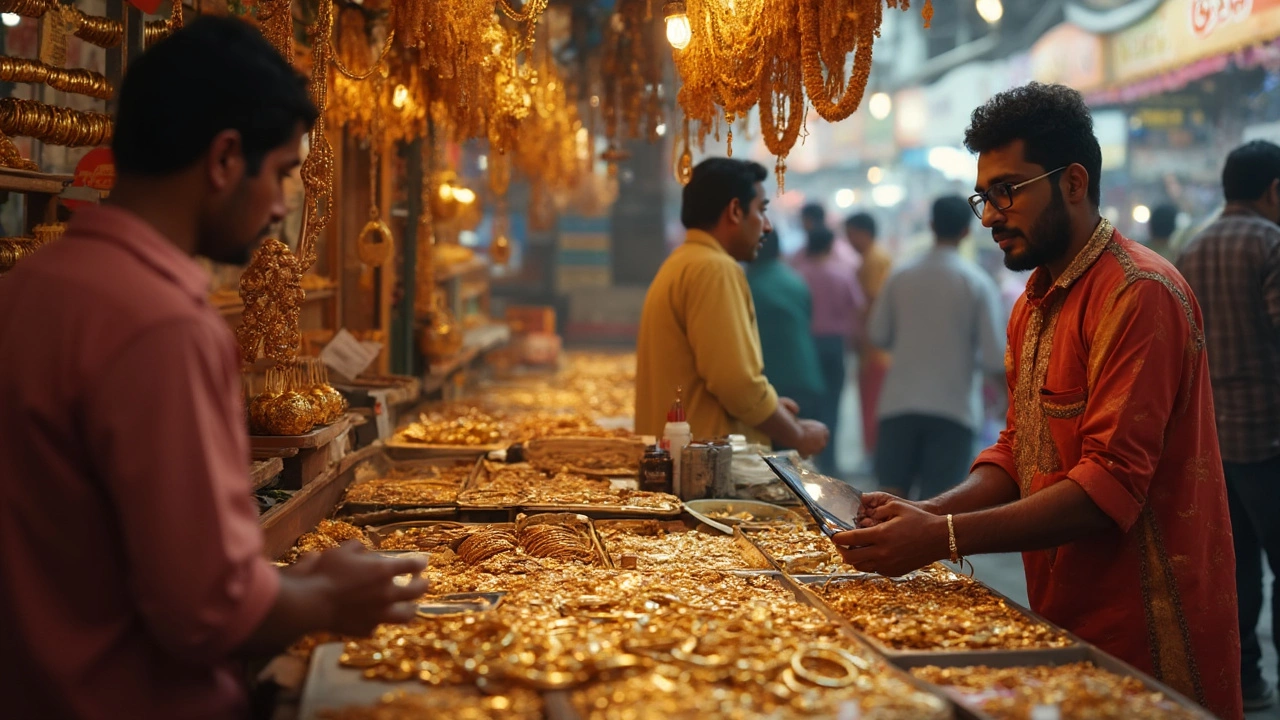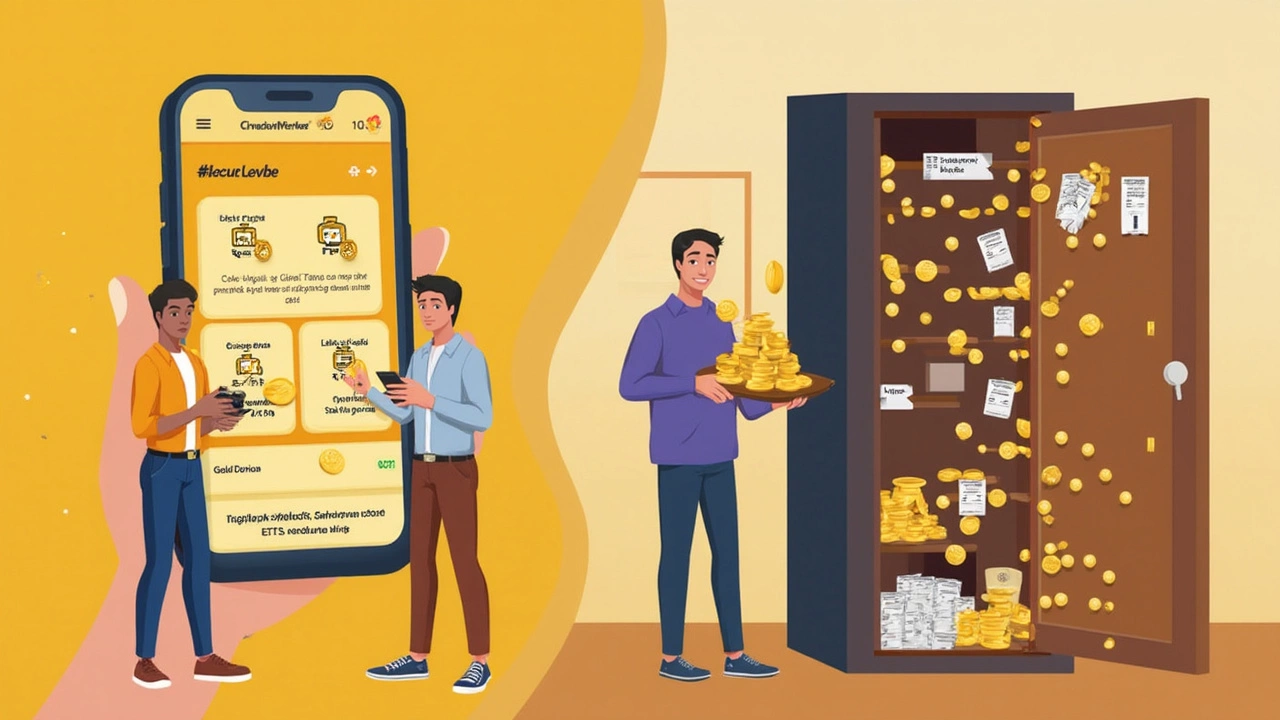If you had $1000 in your pocket and wanted to buy gold in India right now, you'd probably want to know exactly how much you'd get. Gold prices aren't just a number you see on the news — they jump around every day, and where you buy matters just as much as when you buy.
Right now (as of May 8, 2025), gold prices in India are hovering around ₹6,800 per gram for 24 karat gold. If you check the morning rates at top jewellers, it might shift a little higher or lower. It’s not just about the spot price, though; you’ve got to think about taxes, making charges, and how you're buying — physical or digital.
No one likes nasty surprises. If you're planning to use your $1000, you need to factor in all the extras everyone seems to forget until it's too late. Even your choice between coins, jewellery, or gold ETFs can make a difference.
- Checking the Latest Gold Prices
- Buying Physical vs. Digital Gold
- Extra Costs Nobody Tells You About
- How Much Gold Can $1000 Actually Buy?
- Tips to Get the Best Value for Your Money
Checking the Latest Gold Prices
Before you spend a single rupee, you need to know the gold price. Gold rates change every day in India and even a small jump can make a big difference when you’re dealing with $1000. Typically, these prices are tied to what’s happening in the international market, exchange rates, and demand in India after things like Diwali or wedding season. Today, the rate for 24 karat gold (the pure stuff) is about ₹6,800 per gram. If you're eyeing 22 karat gold, it’s a bit cheaper, usually by a few hundred rupees per gram because it's less pure and mixed with other metals.
You can’t just trust any random website for these numbers. The most reliable sources are the Indian Bullion and Jewellers Association (IBJA), major Indian banks like SBI, and big jewellers such as Tanishq, Kalyan, or Malabar Gold. Their sites update rates every day, usually in the morning and sometimes after noon as well if the market jumps.
Here’s what a quick price check might look like on May 8, 2025:
| Type | Price per Gram (₹) |
|---|---|
| 24 Karat (Pure Gold) | 6,800 |
| 22 Karat (Jewellery) | 6,250 |
Keep in mind, these prices don’t include making charges or GST yet — those come later and they matter. Gold is usually quoted per 10 grams, but don’t let that confuse you. Just divide or multiply to see what fits your budget.
The price you see at a jewellery store might be a bit higher than what’s quoted online. That’s normal, because stores add their margin. Always double-check today's price before you walk in to buy.
If you’re thinking of buying digital gold or going for a gold investment through ETFs, the same daily gold rate applies. They might slip in extra fees for storage or transactions, but the base price is set by these daily rates.
Buying Physical vs. Digital Gold
So you’ve got your $1000 ready—what’s better, buying physical gold or switching over to digital? This is a big decision in India right now. Both ways have their own quirks and hidden fees, and the right choice depends on what you care about most: touch-and-feel security, or easy access and storage.
With physical gold, you’re talking coins, biscuits, or jewellery. You get to hold it, gift it, or show it off, but you can’t ignore the extra costs. Jewellers add making charges—usually 3% to even 12% for fancier items. On top of that is 3% GST on the total value. Want smaller coins for easy resale? You often pay a slightly higher price per gram compared to big bars.
Digital gold flips the script. You can buy as little as ₹1 worth at a time from apps like Paytm, PhonePe, or Groww, and your gold is stored with third-party vaults. No worries about locker charges or theft. Redemption is flexible—convert your holding to physical gold and get it delivered, or sell instantly and get cash to your account. But, even here, service providers can charge storage fees if you don’t redeem within 5 years. Prices are generally closer to the real-time market rate, minus tiny transactional charges (often 0.5% to 2%).
"For new-age investors who want flexibility and no headache, digital gold has made entering the market easier than ever before," says Somasundaram PR, CEO of the India Gold Policy Centre.
Here’s a quick look at how fees and charges stack up:
| Type | Common Charges | Ease of Selling |
|---|---|---|
| Physical Gold | GST (3%), Making charges (3–12%) | Requires shop visit; subject to dealer’s buyback policy |
| Digital Gold | Transaction fees (0.5–2%), Storage after 5 years | Instant sale online, direct to bank |
Thinking about gold ETFs and Sovereign Gold Bonds too? These track gold prices, trade like shares, don’t involve storage, and can even pay you interest (in case of SGBs). But remember—no pretty coin to hold, just numbers in your inbox and app.
So when you’re looking to buy gold in India, think about whether you want to store it yourself, pay even a bit extra for that peace of mind, or just keep it all virtual and hassle-free. Whatever you pick, check the platform or jeweller’s reputation—there’s no room for dodgy deals when you’re putting real money down.

Extra Costs Nobody Tells You About
So, you’ve checked the gold price and done the math. If you think that's all you’ll pay—think again. Whether you’re buying physical gold or going digital, there are some costs nobody chats about at the counter.
- GST (Goods and Services Tax): In India, you’ll pay 3% GST on the gold value. This is non-negotiable and slapped on top of whatever price is quoted.
- Making charges: These range from 5%-20% of the gold price if you’re buying jewellery. Even for coins, there’s often a premium added. Bars sometimes come cheaper, but it depends on the seller.
- Dealer commission: If you’re using a broker or a financial platform for gold investment like ETFs or digital gold, you’re probably paying a small brokerage or commission fee—usually between 0.5% to 1.5%.
- Storage and insurance: This one’s sneaky. If you’re buying physical gold and want it safely kept, a bank locker rental or insurance will eat into your yearly budget.
For a reality check, here’s what those extra charges could look like if you spend $1000 (about ₹83,000 right now):
| Cost Type | Rate | Estimated Rupee Amount |
|---|---|---|
| GST | 3% | ~₹2,500 |
| Making/Commission | 7% (avg) | ~₹5,800 |
| Annual Locker (optional) | Varies | ~₹2,000/year |
If you want pure investment value, digital gold or gold ETFs will save you on most physical charges but always double-check the platform’s fee section. Those “zero commission” tags? Sometimes there’s a catch.
The takeaway: don’t just ask for the price per gram—ask for the total. That’s the number that counts when you want to know what your $1000 actually gets you.
How Much Gold Can $1000 Actually Buy?
Let’s break it down with real numbers. As of today, the price of 24 karat gold in India is around ₹6,800 per gram. The current USD to INR conversion rate is close to ₹83 for $1. That means $1000 comes out to ₹83,000.
So, you might think you’ll get a little over 12 grams of gold (₹83,000 ÷ ₹6,800 = about 12.2 grams). But hold on—this isn’t the full story. Jewellers usually add making charges (typically 3–8% for coins, 8–20% for jewellery), and 3% GST applies to all gold purchases.
| Detail | Amount |
|---|---|
| Dollar Amount | $1000 |
| INR Value | ₹83,000 |
| Gold Rate (24k/gram) | ₹6,800 |
| GST (3%) | ₹2,490 |
| Estimated Making Charges (5%) | ₹4,150 |
After accounting for roughly 5% making charges (say you buy coins, not jewellery) and 3% GST, your ₹83,000 turns into about ₹76,360 for the actual gold you get. That comes out to around 11.2 grams—not the 12+ grams you get if you skip the fees.
If you’re buying gold investment options like digital gold, gold ETFs, or sovereign gold bonds, the process is simpler. Fees are lower or hidden in the fund’s charges, but the GST usually disappears. In that case, your $1000 buys almost the full ₹83,000 worth—closer to 12.2 grams.
- Physical gold (coins): Expect 11–11.5 grams after all charges.
- Digital gold, ETFs, bonds: Nearly 12.2 grams, depending on platform fees.
The exact gram weight changes minute by minute with prices and the exchange rate. Always ask for a full price breakdown, including GST and making charges, before you commit. Even small fees can shave a whole gram off your purchase. And if the gold price surges (which has happened more than once in the past year), your $1000 might get you even less tomorrow than it does today.

Tips to Get the Best Value for Your Money
Before you drop your $1000 on gold, there are a few moves you should know to avoid rookie mistakes. Getting the most gold for your money isn’t just about grabbing the lowest price tag—it’s about dodging fees, picking the right product, and knowing the best places to buy. Here's how you can get the best value out of your gold investment.
- Compare rates between top sellers. Don't just take the first price you see. Check online bullion dealers, local jewellers, and banks. Sometimes the difference per gram can be ₹50 or more. Over 14 grams, that's enough to cover your cab ride home.
- Avoid high making charges. Jewellery in India can have making charges that range from 8% to even 20% of your total bill. If you're only after pure gold for investment, look for coins or bars instead. Banks generally sell coins with lower charges, and digital gold has no making costs at all.
- Skip the fancy packaging and designer pieces if you care about pure investment. The fancier the piece, the more you pay—none of which you get back when you sell.
- Check for government-certified purity. Only buy BIS-hallmarked gold if you're buying physical gold. It's your best protection against getting ripped off.
- Consider digital gold or gold ETFs. These don't get eaten up by storage or making charges, and they're way more liquid. A quick stat: by end of 2024, Indian gold ETF assets topped ₹30,000 crore, showing trust in non-physical gold is on the rise.
Here's a quick breakdown of extra charges you might face:
| Type | Extra Charge |
|---|---|
| Jewellery | 8-20% making charges + 3% GST |
| Gold coins/bars (from jewellers) | 2-5% premium + 3% GST |
| Gold ETFs/Digital gold | Small management fee (0.5-1% yearly) |
Last tip? Always insist on a bill and keep every receipt. When it’s time to sell, those papers will save you a headache and get you full value. If you ever need to melt or resell your gold, the paperwork proves you’ve got the real thing. Shop smart and treat gold investment just like any other serious purchase—you’ll thank yourself later.
